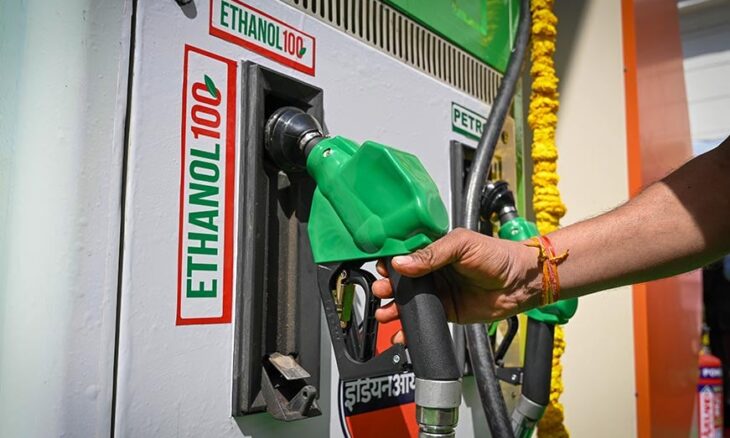
As the Government aims for the E27 milestone in ethanol-based petrol blending – similar to Brazil – it must avoid “slips, trips, and falls” on the way
About five months ago, on March 25, 2025, we published a blog titled “Why the Government Needs to Reassess Its Ethanol Blending Push”. We were among the first to emphasize the need to reassess blending targets from a sustainability perspective.
Since then, many experts have raised similar concerns about E20 – from food inflation to reduced vehicle performance.
Now, as the Government signals intent to move toward E27 in ESY 2027 and beyond – after consultations with the Inter Ministerial Committee – here’s our message in advance:
“Slow is smooth, and smooth is fast.”
This Navy SEAL maxim means that doing things slowly but correctly often gets you to your goal faster than rushing, making mistakes, and backtracking.
India’s Rapid Ethanol Climb

In the last decade, India has surged ahead in ethanol production.
- 2024: 3rd largest ethanol producer in the world, behind only the US and Brazil.
- 2025: Output of 1,630 million gallons, surpassing the entire EU (1,440) and far ahead of China (1,200).
- E20 target: Achieved five years early, ahead of the 2030 goal.
This is commendable – but we must now ask: What has been the trade-off?
Mileage Loss: The Hidden Cost
Ethanol has ~35% less energy per litre than petrol (21.1 MJ/L vs 34.2 MJ/L).
When blended, it reduces the energy per litre of the mix – and therefore mileage – unless engines are optimised for it.
- On an average, mileage loss ≈ 25–30% of the blend percentage.
- Example: E20 → 5–6% mileage drop. E10 → 2–3% drop.
- E27 would mean a mileage drop of about 7–8%.
India’s Current Position

- ESY 2023-24: Average blending rate 14.6% (704.4 crore litres ethanol blended in ~5,000 crore litres petrol).
- ESY 2024-25 (till June): 18.9%, on track for ~20% by year-end.
Economic Impact – Method 1: Based on Additional Petrol Needed
From E15 to E20:
- Mileage loss rises by ~2% (incremental).
- 2% of 5,000 crore litres = 100 crore extra litres needed annually.
- At Rs 60/litre (pre-tax), this costs ₹6,000 crore/year.
From E15 to E27:
- Mileage loss rises by ~3-4% (incremental).
- 4% of 5,000 crore litres = 200 crore extra litres.
- At ₹60/litre, this costs ₹12,000 crore/year.
Economic Impact – Method 2: Based on Total Fossil Fuel Imports
- India spends ~Rs 22 lakh crore/year on fossil fuel imports.
- Crude-derived fuels used in vehicles: Rs 7–9 lakh crore of this.
- Mileage loss from E20: ~6% → Rs 42,000–54,000 crore/year.
- Incremental loss from E15 to E20: Rs 9,000-13,500 crore/year.
- Incremental loss from E15 to E27: ~3-4% loss → Rs 21,000–28,000 crore/year.
Why E27 Could Wipe Out Gains
- Government claim: At E20, forex savings ≈ Rs 43,000 crore/year.
- Our calculation: Mileage losses at higher blends could wipe out 30% or more of this saving.
- Past savings: Rs 1,44,000 crore over 11 years from ethanol blending – but E27 could push net savings toward zero if mileage losses are ignored.
The Bigger Picture
Ethanol blending has environmental and forex benefits, but:
- Ethanol now costs more per litre than refined petrol in India.
- Higher blends hurt mileage in non-optimised engines.
- Higher maize/sugar diversion risks food inflation.
Brazil’s E27 success came with decades of flex-fuel engine development, robust domestic ethanol supply chains, and lower feedstock volatility. India risks “rushing to the summit” without the same foundation.
Even in Brazil today, the mandatory ethanol blend is allowed to vary nationwide between 18% and 27.5% (E27) and is used by all regular gasoline vehicles as well as flexible-fuel vehicles. Moreover, the last thing India would want is to rely on ethanol imports to meet growing demand — a situation Brazil faced in 2011 when a supply shock forced it to import ethanol from the US to meet local demand and keep prices in check.
Conclusion
India’s ethanol journey is a success story – but E27 without engine optimisation, feedstock security, and cost parity will be a slippery slope.
“Slow is smooth, and smooth is fast” applies perfectly here: better to consolidate gains at E20, invest in EVs and renewables, and upgrade vehicle compatibility before pushing higher blends.
#EthanolPolicy #EnergyPolicy #IndiaEnergy #FuelEconomy #SustainableTransport #EnergySecurity
